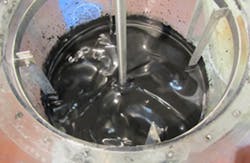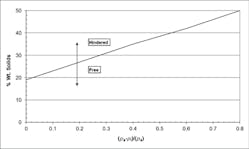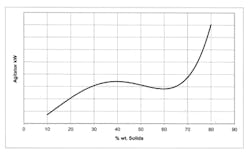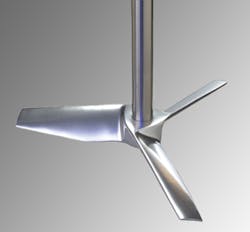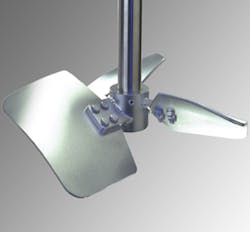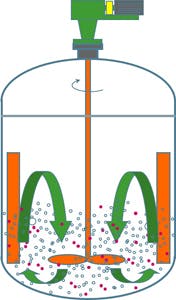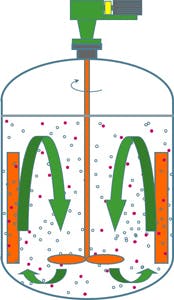High concentration slurries, generally above 40-wt%, do not exhibit free settling behavior and fall into the "hindered" category. In order to design the most appropriate agitator, the slurry rheology needs to be fully understood. This includes particle and liquid densities, solids concentration (percent by weight solids), particle size distribution, and slurry viscosity.
Particle and liquid densities are important because they directly affect the settling velocities of the particles. When settling velocities become low (below 0.3 m/min) and particle interaction increases, the slurry becomes hindered. This is shown in Figure 1.
Solids concentration also has a role in determining the settling characteristics. Importantly, the value at which the slurry becomes hindered—its transition point—will vary from one slurry to another, but is typically between 20% and 50%wt. As concentration increases past this transition point, agitator power typically decreases since the settling velocity of the slurry decreases. Between 65 percent and 75 percent solids, a second transition point occurs where the slurry becomes highly viscous and creates a significant increase in the agitator power demand. Both of these transition points are illustrated in Figure 2. Agitators that will operate near either of these points must be carefully designed, as the requirements for mixing in each zone are quite different from one another.
In terms of particle size, a measurement of size distribution rather than the size of an individual particle is needed for accurate agitator design for slurries. For example, it is not unusual for customers to have slurries with the same weight percent solids and solid specific gravity (and therefore the same slurry specific gravity), but with quite different particle size distributions. The difference in particle size distribution can lead to vastly different agitator power requirements and impeller configurations.
Slurry viscosity is often the most difficult parameter to obtain, yet it influences not only the power level selection, but also affects the number of impellers required and the style of impeller required. For example, at viscosities above 2,000 cps, multiple impellers need to be considered to produce complete motion throughout the vessel, especially tall vessels (vessels with an aspect ratio greater than 1.0). At viscosities approaching 10,000 cps, impeller type becomes very important and high-solidity impellers/close-clearance impellers need to be considered (Figure 3b).
The level of suspension required for the application (i.e. off bottom versus uniform suspension) needs to be defined as well as the rheological properties of the slurry, which affects agitator power level and impeller choice (Figure 4).
For off-bottom suspension, all particles are moving above the bottom of the tank at some vertical velocity, with the larger particles moving at a lower vertical velocity than the finer particles. For uniform suspension, all particles are suspended relatively uniformly throughout the tank with the exception of the top 100 to 150 mm near the surface. Uniform suspension is a relative term as there will be some variation in solids concentration within the tank. The typical level of uniformity that is practically achievable is +/-3%wt. of the mean concentration in the tank. Basically, in the case of uniform suspension, further increase in power will not yield an appreciable improvement in solids concentration variability. Typically, for free settling solids, it is easy to distinguish a difference in off bottom versus uniform suspension.
For hindered slurries, especially those that are viscous, the difference in uniform versus off-bottom suspension is hard to distinguish. In those cases, the viscosity will drive the agitator selection rather than the level of suspension required. Typically when bottom outlets are being specified, a single impeller for off-bottom suspension is sufficient. In that case, a stable clear layer might exist at the very top of the batch during operation. If an overflow outlet is required, there will be a need for a uniform suspension and typically more than one impeller will be needed. Many customers will not desire a clear layer during operation and more than one impeller may therefore be required for cases of off-bottom suspension as well.
In terms of power level and impeller choice, the majority of agitator designs for large slurry storage tanks are based on previous installation experience and laboratory testing of actual slurries.
More recently, theoretical models concerning the zone of influence of the impeller in highly viscous shear thinning fluids have been applied to viscous hindered settling applications. Cavern theory applies when the viscosity level is driving the impeller selection as this theory was developed for non-Newtonian blending of a fluid. The goal is to determine the minimum impeller speed at a given impeller diameter to tank diameter ratio (D/T) to yield minimum motion at the tank wall. The height of the cavern formed will depend somewhat on the impeller type selected but typically is in the 0.4 to 0.6 height-to-tank diameter range. Thus, to achieve full tank motion, it is best to consider multiple impellers if the height-to-tank diameter ratio exceeds these values. Note that theory only predicts bulk fluid motion within the vessel and does not always address the solids suspension portion of the application.
A practical method of selecting agitators for hindered settling is to use existing installation data. Rules exist for many different applications that include power level required (power per unit volume), impeller style and impeller diameter ratio to tank diameter ratio. Many of these sizing methods were developed from small-scale testing in the laboratory.
Lab study techniques
Modeling a hindered settling slurry application in the lab begins by choosing the scale for the test and acquiring a sufficient test sample. For the majority of applications, it has been found through experiment that testing in a test tank of 17.5 inches (445 mm) in diameter is sufficient in size to yield an appropriate scale up to larger vessels (greater than 10 m in diameter). However if sufficient sample is available, testing in even larger scales (24 to 30 inches in diameter or 610 mm to 760 mm) is recommended. The scale-up factor can be experimentally tested as well by considering tests in two scales. It is key to maintain geometric similarity from the lab scale to the full-scale, which includes baffle dimensions, tank dimensions and agitator impeller dimensions. Baffle width needs to be evaluated based on the viscosity level. As viscosity builds, the width of the baffles needs to be reduced.
A typical lab test setup is shown in Figure 5. Utilizing plastic clear tanks allows for the slurry motion obtained in the test tank to be observed, although motion on many slurries can be very difficult to see. If insufficient agitation is obtained, clear layers near the top as well as a progressive corner fillet near the bottom can easily be observed. Taking samples from both the top and bottom of the test tank and testing for concentration is a good way to ensure uniformity.
A particle size distribution can be performed on the samples as well to see if there are any differences from top to bottom. It is important to allow the mixer to operate for at least four hours to see if the given configuration yields the desired process results.
Impeller speed as well as torque should be measured as this is generally used for scale up. A single test run with a given impeller style can be used to generate a full-scale mixer design. The high efficiency hydrofoil impeller (Figure 3a) is generally the choice for most hindered settling slurry applications. However, if time permits, it is best to run several configurations especially if an optimized design is to be obtained. These parameters include, but are not limited to, the following:
- Impeller D/T (impeller diameter to tank diameter ratio). A typical range if 0.3-0.5. There is often an optimum D/T value that yields the least amount of torque for a given slurry
- Number of impellers. Typically for batch aspect ratios higher than 1.0, two impellers need to be chosen. For aspect ratios between 0.5 and 1.0, more than one impeller may need to be considered depending on viscosity level and desired level of suspension but are not always necessary.
- Impeller pumping direction can affect the amount of power required for a given application. A dual-impeller configuration utilizing a down pumping lower impeller and an up pumping upper impeller can yield better surface motion and sufficient suspension for less power than a dual-down pumping impeller configuration. This configuration has proven to be successful in highly viscous applications (e.g. Fly Ash Suspension) or fast settling slurry applications (e.g. Iron Ore Suspension).
Keys to success
A successful agitator installation for a hindered settling slurry tank requires a full understanding of the rheology of the slurry prior to design, as well as the desired process results (i.e. off-bottom versus uniform suspension). Existing installations and mixing theory can be used to arrive at an agitator design that will achieve the desired process results.
Lab work is the best way to determine the rheology of the slurry and the optimum impeller configuration and power level required to achieve the desired process result. The lab test setup must be carefully chosen to ensure the results can be successfully used for process scale up.
Both past installation success and recent lab test results have shown that an upper up pumping impeller paired with a down pumping lower impeller can yield a more optimum agitator design. A lower power requirement and thus torque requirement should directly lead to a lower initial cost installation and annual operational savings through a reduction in consumed power.
References
- R. Kehn, G. Seal, R. Stewart, B. Gigas, "Agitator Design for Large Hindered Settling Slurry Tanks," ALTA Mining Conference Perth Australia 2009.
- R. Kehn, "Process Design Requirements for Hindered Settling Slurry Tank Agitators," World Congress of Chemical Engineering Conference Montreal, PQ. 2009.
- James Y. Oldshue, "Fluid Mixing Technology," McGraw Hill Publication Co, NY, NY USA 1983.
Richard Kehn is Senior Technologist—Mixing, at Lightnin, an SPX brand. It is part of SPX Flow Technology, a segment of SPX that designs, manufactures and installs highly engineered solutions used to process, blend, meter and transport fluids, in addition to solutions for air and gas filtration and dehydra-tion. Mr. Kehn has a bachelor’s degree in Chemical Engineering from Rensselaer Polytechnic Institute and is pursuing a master’s in Mechanical Engineering (concentration in Fluid Dynamics) from Rochester Institute of Technology. Mr Kehn has writ-ten/co-written eight technical papers regarding mixing, covering low viscos-ity blending, copper solvent extrac-tion, slurry tank agitator design, effect of mechanical fluid forces on mixing and practical use of CFD for mixing applications. Areas of mix-ing expertise include the mining, water treatment, pulp and paper, and chemical industries. He can be reached at [email protected]. For more information on SPX Lightnin please visit: www.spx.com/en/lightnin.
